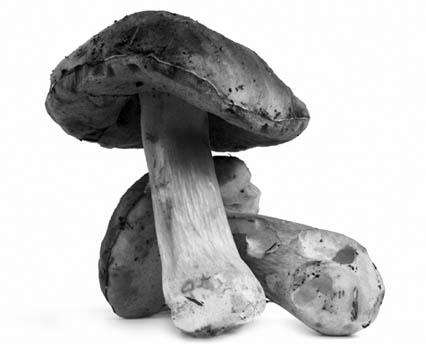Growing Mushrooms In Your Garden
Fabulous Fungi

Usually when I write about mushrooms, I’m talking about some beneficial fungus that aids in the decomposition of mulch or evidence of the nasty armillaria that can be so detrimental to our native oaks (and other plants). Today, though, I’m talking about those fungal wonders that add their particular texture and earthy flavor to all sorts of dishes. Mushroom hunting is not for the faint of heart and requires an excellent knowledge of what the edible ones look like; mushroom poisoning can cause severe gastrointestinal pain and even death. Most people stay with cultivated mushrooms to get their ‘shroom fix.
It used to be that edible mushrooms came in just one or two types at the market and even when mushroom growing kits appeared they were likely to be for the ubiquitous Agaricus bisporus. This is the very familiar white-capped mushroom still found in everything from pizza to cream of mushroom soup. Lately, however, more types of fresh mushrooms have made an appearance. It is now possible to have a wide variety of fresh fungi, not only from the market, but to grow yourself. Dried mushrooms certainly retain all the flavor of fresh, but the texture never fully recovers on soaking. Growing them at home allows you to harvest them at peak freshness and have the best flavor and texture available instantly.
Mushrooms are the reproductive structures of a fungus. Most of the time, the vegetative body of the fungus lives unseen as extremely thin filaments spread through its favorite medium. The medium may be very specific for each type, from wood to dung, for example. Whatever it is, it provides a source of carbon that the fungi need. They are literally digesting the material by releasing powerful enzymes to break it down. Therein lays the crux of the problem with growing them out of their natural environment. The revolution in growing mushrooms commercially is testimony to the growers’ increasing knowledge about how to coax them to thrive in an artificial setting. The great thing about all that knowledge is that it has spilled over to hobbyist growers, as well. Mushroom growing kits, spawn, and other paraphernalia are readily available for many species.
The simplest of mushroom kits will probably look like a plastic bag stuffed full of straw or sawdust with some holes punched through the plastic film. These have been sown with the spores of a particular species and all you have to do is dampen the kit according to directions included and maintain it at the optimum temperature for that species. Within weeks to months, depending on the species, the mycelium will have grown outward and mushrooms will sprout from the holes. You pluck them off as they appear and head for the kitchen. The leftover medium can often be coaxed to continue fruiting if given an additional source of carbon. You can stuff it into the cracks of a log or sprinkle it at the edge of a mulch or compost pile and hope that the mycelium finds its way into the new medium. Of course, inventive growers have gone on to develop much more complicated growing systems, with humidity domes, automatic heating and watering systems, and more.
Once you are hooked on growing your own mushrooms, there are also ways to grow them outdoors. Many grow well on wood, so manufacturers have developed a way to inoculate a small plug (looks much like a wine cork) that you can stuff into holes drilled in a log or stump. Once established, these logs can produce mushrooms for many years until the whole has been decomposed.
Here are a few mushrooms that you can now grow at home. The trendy Portobello is just a very large version of the cremini (or baby bella) mushroom and is the same species as the white mushroom noted above, just a wilder relative. Easy to grow and very productive, kits will produce a flush every 10 days to two weeks until the medium is exhausted.
Enokitake, or enoki mushrooms (Fammulina velutipes), grow as pale thread-like stems topped with tiny rounded caps. In nature, they grow on wood, but commercial kits may contain sawdust, rice bran, and corncob meal. They prefer cool temperatures (40°F to 60°F) to thrive.
While their flavor is no more special than any other mushroom, the morel (Morchella species) has long been sought after. Its cultivation has been in development for many decades. Success is now assured with new techniques and cultures. Taste may have suffered a bit in this endeavor, but their crinkled shape is a favorite nonetheless. Fairly easy to grow outdoors, in our mild climate, these may fruit at any time of the year.
Oyster mushrooms (Peurotus species) come in a wide array of colors including pink, yellow, blue, and nearly black. The most commonly grown one is pale white, turning to buff on the off-center caps. Their flavor is also among the least tantalizing, but different media will produce more intensity. One Web information site even touts a type of oyster mushroom that grows on coffee grounds.
Shiitake mushrooms (Lentinula edodes and Lentinus edodes) were first cultivated in China as long ago as 960 AD. Over 1,000 years later, they came into production in the U.S. Their robust flavor and handsome dark color are universally beloved, and now you can grow your own. A shiitake kit can produce two to three pounds of mushrooms over a 12- to 16-week period.
Mushroom hunting is still a fantastic way to enhance your gourmet rating with friends and relations for whom you cook. However, if you are squeamish about making the call between safe and sorry, growing them at home is a good way to bring the woodsy flavor of mushrooms into the kitchen.



